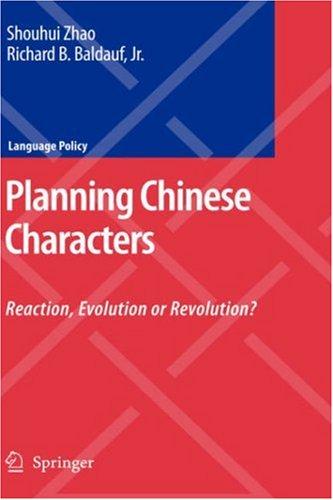Bund für vereinfachte rechtschreibung (BVR)
Planning Chinese Characters
autoren
Zhao, Shouhui
Baldauf, jr., Richard B.
titel
Planning Chinese Characters.
untertitel
Reaction, Evolution or Revolution?
reihe
Language Policy
band
9
verlag
ort
D-Berlin
datum
2008
isbn
978-0-387-48574-4
umfang, ausstattung
gebunden, XX, 420 s., abb.
online-bibliotek
umschlag

Inhaltsverzeichnis (auszug)
| 1. | Making Hanzi Accessible |
23 |
| 2. | Reflections on New Perspectives |
71 |
| 3. | New Challenges for a Digital Society |
111 |
| 4. | Standardization as a Solution |
137 |
| 5. | Influencing Outcomes |
191 |
| 6. | Envisioning the Future |
249 |
| 7. | Some Critical Issues |
287 |
Verlagstexte
The barriers to growth and spread of the Chinese language are very different for spoken and written Chinese, and this monograph focuses on the written variety. It traces the language policy and planning related developments for Chinese characters, with particular emphasis on post-1950 period in the People's Republic of China (PRC) and the more recent challenges that technology, and particularly the World Wide Web, have posed for the language. While Chinese language policy and planning developments can generally be characterized as evolutionary, currently there are forces, both reactionary, i.e. elements of traditional language and cultural purism, and revolutionary, i.e. 'alphabetic' or radical simplification schemes, at work in the PRC. The volume examines this linguistic, cultural, political, economic debate, the outcome of which could determine whether Chinese reaches its international language potential, and explores some possible language policy and planning directions for the future. Given the importance of China and potential of the Chinese language, understanding of these issues is critical for not only our understanding of China, but for second language policy as it relates to Chinese around the world.
Die hindernisse für wachstum und verbreitung der chinesischen sprache sind für gesprochenes und geschriebenes chinesisch sehr verschieden, und diese monografie konzentriert sich auf die geschriebene variante. Es verfolgt die entwicklung der sprachpolitik und -planung bezüglich der chinesischen schriftzeichen mit besonderer berücksichtigung des zeitraums nach 1950 in der Volksrepublik China (VRC) und die jüngsten herausforderungen, die die technik und besonders das world wide web der sprache stellen. Während die chinesische sprachpolitik und -planung im allgemeinen als evolutionär charakterisiert werden können, gibt es gegenwärtig in der VRC bestrebungen sowohl reaktionärer art, d. h. traditionelle sprachelemente und kulturellen purismus, als auch revolutionärer art, d. h. „alphabetische“ oder radikale vereinfachungsvorschläge. Der band untersucht diese sprachliche, kulturelle, politische, ökonomische debatte, deren ergebnis bestimmen könnte, ob chinesisch sein internationales sprachpotenzial erreicht, und erforscht mögliche zukünftige wege der sprachpolitik und -planung. In anbetracht der bedeutung Chinas und des potenzials der chinesischen sprache sind diese fragen nicht nur für unser verständnis von China wichtig, sondern auch für chinesisch als zweitsprache in der ganzen welt.
The whole world has been watching the vast changes that are currently occurring in China, but few people are aware that at the same time, to ensure the writing system serves these changes well, Chinese characters have also undergone significant reform. While focusing on current problems, developments and possible solutions, this book also details the major implementation of language planning programs for the modernization of the Chinese writing system that have occurred over the last century.
The volume provides a broad and in-depth analysis of the conflict between one of the world’s oldest surviving script systems and the latest developments in communication technology. Comprehensive in coverage, interdisciplinary in structure, with copious references to assist readers in locating a wide range of resources, this book offers an analytic discussion of character planning that will prove of great value to language policymakers and those who are interested in China/East Asian studies and sinology.